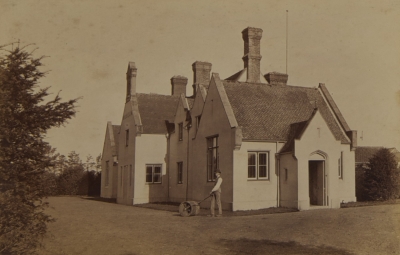To search the RPR site click here
The following extract is from a talk given by Pitt-Rivers in 1889-90 at Blackmore Museum, Salisbury entitled 'On the Uses and Arrangement of Arts Museums', the full copy of this address can be found here. The photograph shown here shows what the Farnham Museum buildings look like in 2012, please note that the building is now a private residence and is no longer open to the public.
The transcript is taken from P142d, Salisbury and South Wiltshire Museum Pitt-Rivers papers:
...Since presenting my Collection to Oxford, finding myself on my legs again, and capable of work to an extent I had never anticipated, and thinking that possibly my Oxford Collection might not develop exactly in the way I desired, I have formed another Collection, which I have located in the Village of Farnham, Dorset, and which, though not at all equal in extent, to the one now at Oxford, will probably form the nucleus of a new Museum which may perhaps ultimately be presented to some other place, whilst at the same time it serves the distinctly different function of a Local Museum for the district in which it is situated. I exhibit a Plan of this establishment. One room 30 feet by 16 feet, and part of another room is devoted to [insert] Local [end insert] Antiquities, and includes Models to scale, of two Romano-British Villages in the neighbourhood, that I have excavated. Another Model represents the excavations recently conducted at Woodyates and in Wansdyke. There are also Models of some Barrows in the vicinity, whilst the Antiquities from all these several places are exhibited in cases surrounding the Models so that the enquirer can ascertain for himself the exact spot in which each object was found. This part of the Museum will serve the function of a Museum of Research for Archaeologists, who may visit the neighbourhood, and who wish to know what it contains and to see the Antiquities that have been found in the District. The rest of the Museum must be regarded as the commencement of an educational series, though not as yet fulfilling that function to the extent that I hope it will do ultimately. It occupies 6 rooms one of which is 84 feet by 16 feet, and consists of a Collection of the Pottery of different Nations, Savage, Barbarous, and Modern, a Collection of Peasant Carvings, Household Appliances, a series of Agricultural Tools, Ancient and Modern, a collection [insert] series [end insert] shewing the derivation of our modern system of Roofing from the Tegulae and Imbrices of the Romans, a series of Models illustrating the history of the plough, another exhibiting the development of Country Carts, and a Collection of Ancient and Modern Door Locks shewing the gradual development of their forms, about which I have published a separate treatise. During the last year it was shown, by the Visitor's Book that from September 1888 to September 1889, it was visited by 6,152 persons, which considering that it is 10 miles distant from every Town and Railway Station, and that it is situated in a sparsely populated, agricultural District, is a larger number than I ever expected, and shews that it is already serving a useful purpose.
In making these Collections, I have been guided by the principle, that in a purely agricultural District, the several subjects represented in the Museum, should have some relation either to Agriculture, or the matters connected with Peasant life. I have sometimes noticed, that in Museums in large Towns and elsewhere, the visitors will often wander listlessly through the galleries, without taking much notice, until they come to something that they understand a little about. Then their interest commences, and they appear anxious to improve their knowledge of the subject, that has attracted their notice. I do not mean to infer that all agricultural people are incapable of paying attention to anything but their own calling, but as a rule their interest will be more keenly excited by subjects that they are more or less familiar with. A friend of mine was in the habit of relating the following story, which has a strong bearing on this particular phase of the human mind that I am speaking about. Living in the country and being of a philanthropic disposition, he was anxious to improve the minds of his neighbouring villagers by means of lectures. He therefore engaged the services of a scientific gentleman from London who came down and delivered three lectures in the village schoolroom upon Optics. The audience appeared pleased, and the lecturer himself especially so, at the opportunity afforded him of displaying his knowledge before an apparently appreciating assembly. At the end of the third lecture, it was thought proper to ask one of the most well-to-do Farmers in the room to return thanks to the lecturer. The Farmer having accepted the suggestion, that he should be the spokesman of the party rose and addressed the Meeting in thiswise. "I've been a asked to return thanks to the gentleman for his extremely interesting lecture, and I'm sure wes all extremely obliged to him, I avent myself eard all on em, but only this ere last one, because business is business and times is bad, but I am much obliged to the gentleman for what I have heard. It is'nt [sic] often that the like of we, has the opportunity of hearing an interesting discourse the like of this ere. I should be sorry to say anything as seems like finding fault, as the saying uz, and there arent no call for it neither, but there's only one remark that I should like to make to the gentleman, as a practical man, and that is, I eared un call un Op-sticks, now ere abouts, leastwise in Kent, we allers calls un Op-poles and not Op-sticks." ** No doubt the Lecturer's countenance must have fallen upon hearing this Address, and it was certainly not encouraging, but we may learn from it that, whether the case of lectures or Museums, any one who makes the mistake of shooting over the heads of the people he wishes to instruct is bound to miss his mark. Evolution is the order of all nature, and applies equally to the mode of imparting instruction. Every new idea, in order to be well understood must be built upon a carefully prepared foundation.
Transcribed by AP for the Rethinking Pitt-Rivers project August 2011





